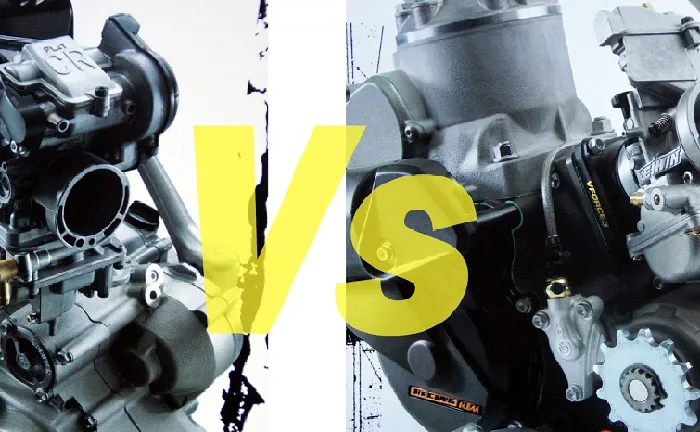When choosing between a 2-stroke and a 4-stroke engine, it’s essential to understand their differences, advantages, and disadvantages. This article will provide a comprehensive overview to help you decide which engine type best suits your needs.
What Are 2-Stroke and 4-Stroke Engines?
2-Stroke Engines
A 2-stroke engine completes a power cycle in just two strokes of the piston (one crankshaft revolution). This engine type is commonly used in applications where weight and size are critical, such as chainsaws, dirt bikes, and outboard motors.
4-Stroke Engines
In contrast, a 4-stroke engine completes a power cycle in four strokes of the piston (two crankshaft revolutions). This engine type is prevalent in larger applications, including automobiles, motorcycles, and lawnmowers, due to its efficiency and durability.
Key Differences Between 2-Stroke and 4-Stroke Engines
1. Power Output
2-Stroke Engines:
These engines deliver a power stroke with every revolution of the crankshaft, resulting in a higher power-to-weight ratio. This makes them ideal for applications requiring high power in a compact form.
4-Stroke Engines:
In a 4-stroke engine, power strokes occur once every two revolutions. While this means a lower power output per engine size, the engine can operate more efficiently, particularly at lower RPMs.
2. Fuel Efficiency
2-Stroke Engines:
Typically, 2-stroke engines consume more fuel than their 4-stroke counterparts because they burn oil mixed with fuel for lubrication. This can lead to inefficient fuel combustion, resulting in lower fuel economy.
4-Stroke Engines:
4-stroke engines generally have better fuel efficiency. They have a dedicated lubrication system that helps them use fuel more effectively, leading to lower fuel consumption over time.
3. Emissions
2-Stroke Engines:
Due to the design and fuel mixture, 2-stroke engines produce more exhaust emissions. The incomplete combustion of fuel and oil contributes to higher levels of unburned hydrocarbons, making them less environmentally friendly.
4-Stroke Engines:
These engines produce fewer emissions as they have more complete combustion cycles. They are often designed to meet stricter environmental regulations, which can be an essential consideration for many consumers.
4. Complexity and Maintenance
2-Stroke Engines:
The design of a 2-stroke engine is simpler, with fewer moving parts. This can make maintenance easier and repairs cheaper. However, they often require more frequent maintenance, particularly with regard to the fuel mixture and lubrication.
4-Stroke Engines:
4-stroke engines are more complex, featuring a separate lubrication system, valves, and a more intricate cooling system. While this complexity can lead to higher initial costs and maintenance requirements, they tend to be more durable and require less frequent servicing.
5. Weight and Size
2-Stroke Engines:
Because of their simpler design, 2-stroke engines are generally lighter and smaller. This characteristic makes them ideal for portable equipment where weight is a significant factor.
4-Stroke Engines:
4-stroke engines are typically larger and heavier due to their additional components. This can be a disadvantage in applications where portability is essential, but it often means better stability and performance in larger machines.
6. Noise and Vibration
2-Stroke Engines:
These engines are often noisier and produce more vibration than 4-stroke engines. This can be a significant downside for applications where quiet operation is desired, such as residential lawn equipment.
4-Stroke Engines:
4-stroke engines generally operate more quietly and with less vibration, making them more suitable for residential areas and applications where noise levels are a concern.
Applications: When to Choose Each Engine Type
When to Choose a 2-Stroke Engine
Power-to-Weight Ratio: If you need maximum power in a lightweight package, such as for racing or specific outdoor equipment.
Portability: Ideal for handheld tools or portable machinery, like chainsaws and leaf blowers.
Cost-Effectiveness: If upfront costs are a significant concern and you’re okay with higher fuel consumption.
When to Choose a 4-Stroke Engine
Fuel Efficiency: If you’re looking for better fuel economy and longer intervals between maintenance.
Durability: If you need a reliable engine for heavy-duty applications like cars or lawnmowers that can withstand regular use.
Environmental Considerations: If emissions are a priority for you, such as in residential areas or regulated environments.
Conclusion: Making the Right Choice
Both 2-stroke and 4-stroke engines have their unique advantages and disadvantages. The choice ultimately depends on your specific needs, including factors like power requirements, fuel efficiency, maintenance preferences, and environmental concerns.
Choose 2-Stroke for lightweight applications, higher power output, and simpler designs.
Choose 4-Stroke for efficiency, durability, and lower emissions.
Understanding these differences will empower you to make an informed decision that aligns with your requirements, ensuring you select the right engine for your project or application.
Related topics:
- How Many Watts Can An Extension Cord Handle?
- How To Raise The Deck On A Husqvarna Riding Mower?
- Do You Have To Connect Ground Wire For Light Fixture?

